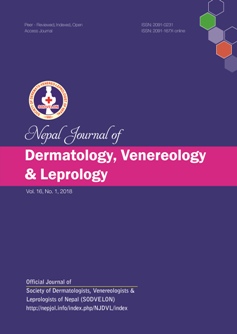Cutaneous Leishmaniasis: A Neglected Vector Borne Tropical Disease in Midwestern Region of Nepal
DOI:
https://doi.org/10.3126/njdvl.v16i1.19405Keywords:
Biopsy, fine-needle, disease vectors, Leishmania, cutaneous, Nepal, Phlebotomus, ulcerAbstract
Introduction: Cutaneous Leishmaniasis is a vector borne disease caused by the bite of an infected sandfly. The disease is rare in Nepal with only few cases reported till date. We report the largest collection of patients over six years.
Objective: To describe the clinical, epidemiological and pathological aspect of Cutaneous Leishmaniasis in Midwestern region of Nepal.
Materials and Methods: Thirty-three patients referred to the department of Pathology for fine needle aspiration were diagnosed as Cutaneous leishmaniasis based on detection of Leishmania donovani in the fine needle aspiration smears. Demographic data and clinical details including site, size, and duration of disease onset were recorded on a printed proforma. Statistical analysis was done using SPSS version16.0 for windows.
Results: A total of 33 patients with age ranging from 11 years to 65 years were included in the study. Mean age was 26.5±11.5 years. Most patients were in the age group 21-40 years. Male: Female ratio was 1.7:1. Mean duration of disease was 5.3±4.4 months. Thirty patients had single lesion. Lesions were either of plaque type (84.9 %) or papulonodular type (15.1%).
Conclusion: Cutaneous leishmaniasis is uncommon in Nepal. So, it is often neglected. It is in an increasing trend. Cutaneous leishmaniasis should be included in the differential diagnosis of a non-healing ulcer.Downloads
Downloads
Published
How to Cite
Issue
Section
License
Copyright on any research article is transferred in full to Nepal Journal of Dermatology, Venereology & Leprology upon publication. The copyright transfer includes the right to reproduce and distribute the article in any form of reproduction (printing, electronic media or any other form).




